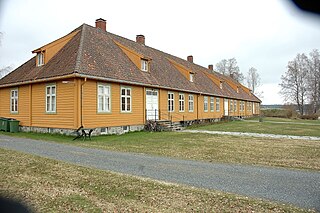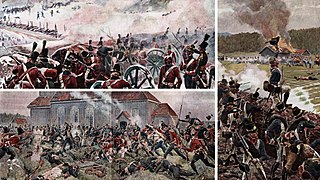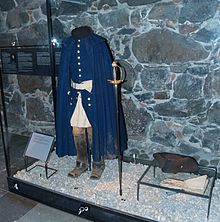
Charles XII, sometimes Carl XII or Carolus Rex, was King of Sweden from 1697 to 1718. He belonged to the House of Palatinate-Zweibrücken, a branch line of the House of Wittelsbach. Charles was the only surviving son of Charles XI and Ulrika Eleonora the Elder. He assumed power, after a seven-month caretaker government, at the age of fifteen.

Halden, between 1665 and 1928 known as Fredrikshald, is both a town and a municipality in Østfold county, Norway. The municipality borders Sarpsborg to the northwest, Rakkestad to the north and Aremark to the east, as well as the Swedish municipalities Strömstad, Tanum and Dals-Ed respectively to the southwest, south and southeast.

Carlsten is a stone fortress located at Marstrand, on the western coast of Sweden. The fortress was built on the orders of King Carl X of Sweden following the Treaty of Roskilde, 1658 to protect the newly acquired province of Bohuslän from hostile attacks. The site of Marstrand was chosen because of its location and its access to an ice free port. The fortress was decommissioned as a permanent defense installation in 1882, but remained in military use until the early 1990s.
In the First Northern War from 1655 to 1660, during the reign of Charles X, Sweden was set on expansion. Through military action, Sweden rapidly became the strongest military power in the north.

Bohus Fortress lies in Kungälv, Bohuslän, Sweden, north east from Hisingen where the Göta river splits into two branches. It commands the surrounding area from a cliff 40 m (130 ft) high, with the river forming a natural moat around it. The fortress used to be situated along the old Norwegian–Swedish border.

Blaker Fortress is a former defense facility located at the village of Blaker in Akershus country, Norway.

The Great Northern War was the war fought between a coalition of Denmark–Norway, Russia and Saxony-Poland on one side and Sweden on the other side from 1700 to 1721. It started by a coordinated attack on Sweden by the coalition in 1700, and ended 1721 with the conclusion of the Treaty of Nystad, and the Stockholm Treaties. As a result of the war, Russia supplanted Sweden as the dominant power on the shores of the Baltic Sea, becoming a major player in European politics.

The Scanian War was a part of the Northern Wars involving the union of Denmark–Norway, Brandenburg and Sweden. It was fought from 1675 to 1679 mainly on Scanian soil, in the former Danish–Norwegian provinces along the border with Sweden, and in Northern Germany. While the latter battles are regarded as a theater of the Scanian war in English, Danish, Norwegian and Swedish historiography, they are seen as a separate war in German historiography, called the Swedish-Brandenburgian War.

New Älvsborg, so-called to distinguish it from the earlier fortress at Old Älvsborg, is a sea fort on the island of Kyrkogårdsholmen within the urban area of modern Gothenburg, Sweden. Situated near the mouth of the Göta River, it protected what was at the time of its construction Sweden's only access to the North Sea and the Atlantic Ocean. Construction began in 1653, and the fortress remained in service until 1869, though it only saw significant action in one conflict, the Great Northern War.
Anthony Coucheron was an engineering officer. Coucheron played an important role in the history of Norwegian and Danish fortifications. As Sweden grew to be a great power in the 17th century, there were frequent wars in the Baltic region, and conflict was common along the borders between Sweden & Denmark-Norway. Easy invasions routes from Sweden were fortified on the Danish-Norwegian border with new or upgraded fortresses during this period, effectively establishing the modern borders between Norway & Sweden. Anthony Coucheron played a major role in fortification of the border, both in Norway and Denmark in addition, he participated with honor in combat during the Gyldenløve War.
Jørgen Christopher von Klenow was a Dano-Norwegian military officer.

The Dano-Swedish War of 1658–1660 was a war between Denmark–Norway and Sweden, with the former backed by the Dutch Republic and Poland. It is known in Denmark as the Second Karl Gustav War, in Norway as Bjelkes Feud in Sweden as Karl Gustav's Second Danish War, and in the Netherlands as the Swedish-Dutch War.
Vincens Budde was a Norwegian officer, born in 1660 in Halden, Norway into a Norwegian military family. Budde was promoted to colonel 1710 and to major general in 1716.
The military history of Norway commences before the Viking Age with the internal wars fought between regional kings to obtain the supreme kingship of the whole of Norway. The most famous period of Norwegian history and thus military history is the Viking Age, but the early Middle Ages was the era when Norwegian military power in Europe reached its peak. Since then the Norwegian military has experienced long periods of neglect, but also rearmament and victories.

Jørgen Bjelke was a Norwegian officer and nobleman. He was born at Elingaard Manor on Onsøy near Fredrikstad, in Østfold County, Norway and died in Kalundborg, Denmark.

The siege of Fredriksten was an attack on the Norwegian fortress of Fredriksten in the city of Fredrikshald by King Charles XII of Sweden. While inspecting his troops' lines, Charles XII was killed by a projectile. The Swedes broke off the siege, and the Norwegians held the fortress. Along with the Treaty of Nystad three years later, the death of Charles XII marked the end of the imperial era in Sweden, and the beginning of the Age of Liberty in that country.

The Dano–Swedish War of 1808–1809 was a war between Denmark–Norway and Sweden due to Denmark–Norway's alliance with France and Sweden's alliance with the United Kingdom during the Napoleonic Wars. Neither Sweden nor Denmark-Norway had wanted war to begin with but once pushed into it through their respective alliances, Sweden made a bid to acquire Norway by way of invasion while Denmark-Norway made ill-fated attempts to reconquer territories lost to Sweden in the 17th century. Peace was concluded on grounds of status quo ante bellum on 10 December 1809.

The Attack on Marstrand was a successful Dano-Norwegian siege of the Swedish town of Marstrand and Carlsten fortress which took place between July 10 and July 16, 1719 during the end of the Great Northern War.

The battles at Göta älv were a series of battles and sieges which took place in and around the Gothenburg area between 1717 and 1719, between the Swedish Empire and Denmark–Norway, during the Great Northern War.




















